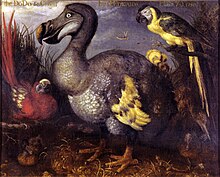Martinique macaw
| Martinique macaw | |
|---|---|

| |
| Hypothetical 1907 illustration by Keulemans, based on Bouton's description | |
| Scientific classification | |
| Domain: | Eukaryota |
| Kingdom: | Animalia |
| Phylum: | Chordata |
| Class: | Aves |
| Order: | Psittaciformes |
| Family: | Psittacidae |
| Genus: | Ara |
| Species: | A. martinicus
|
| Binomial name | |
| Ara martinicus (Rothschild, 1905)
| |

| |
| Location of Martinique | |
| Synonyms | |
|
List
| |
The Martinique macaw or orange-bellied macaw (Ara martinicus) is a
The Martinique macaw is one of 13
Taxonomy

The Martinique macaw was
What Bouton described is likely to remain a mystery, but various theories have been proposed.
In the article that named the Martinique macaw, Rothschild also listed an "Anodorhynchus coeruleus", supposedly from
Extinct Caribbean relatives

Macaws are known to have been transported between the Caribbean islands and from mainland South America both in historic times by Europeans and natives, and prehistoric times by

Many hypothetical extinct macaws were based only on contemporaneous accounts, but these species are considered dubious today. Several of them were named in the early 20th century by Rothschild, who had a tendency to name species based on little tangible evidence.
Other species of macaw have also been mentioned, but many never received
Contemporary descriptions

Bouton's 1630s description of the Martinique macaw is reproduced below, translated from French:
The macaws are two or three times as large as the other parrots, [and] have a plumage much different in colour: those that I have seen have their plumage blue and orange-yellow (saffron). They also learn to talk and have a good body.[4][10]
A translation of the 1658 French description of "Ara erythrura" by de Rochefort follows below:
Among them are some which have the head, the upper side of the neck, and the back of a satiny sky blue; the underside of the neck, the belly, and undersurface of the wings, yellow, and the tail entirely red.[4]
In spite of the fact that the tail of "Ara erythrura" was described as entirely red, the plate in Rothschild's Extinct Birds showed a blue tip, which the American ornithologist Charles Wallace Richmond complained about in his review of the book.[17]
References
- ^ a b Birdlife International (2016). "Ara guadeloupensis". www.birdlife.org. Retrieved January 10, 2016.
- ^ a b IUCN Red List (2013). "Ara guadeloupensis". www.iucnredlist.org. Archived from the original on 26 September 2013. Retrieved January 10, 2016.
- ^ Rothschild, W. (1905). "Notes on extinct parrots from the West Indies". Bulletin of the British Ornithologists' Club. 16: 13–15.
- ^ a b c d e Rothschild, W. (1907). Extinct Birds. London: Hutchinson & Co. pp. 53–54.
- ^ a b c d Wiley, J. W.; Kirwan, G. M. (2013). "The extinct macaws of the West Indies, with special reference to Cuban Macaw Ara tricolor". Bulletin of the British Ornithologists' Club. 133: 125–156.
- ^ ISBN 978-0-8493-2001-9. Archived from the original(PDF) on 2014-02-07.
- ^ ISBN 978-0-670-81787-0.
- ^ .
- ^ ISBN 978-0-486-21869-4.
- ^ a b "Species Info: Ara martinica". The Extinction Website (2008). Archived from the original on 2 October 2008. Retrieved 5 October 2008.
- ^ ISBN 978-1-4081-5725-1.
- ^ S2CID 54593515.
- .
- S2CID 254158608.
- ^ Lenoble, A. (2015). "The Violet Macaw (Anodorhynchus purpurascens Rothschild, 1905) did not exist". Journal of Caribbean Ornithology. 28: 17–21.
- S2CID 87386694.
- JSTOR 4070727.
